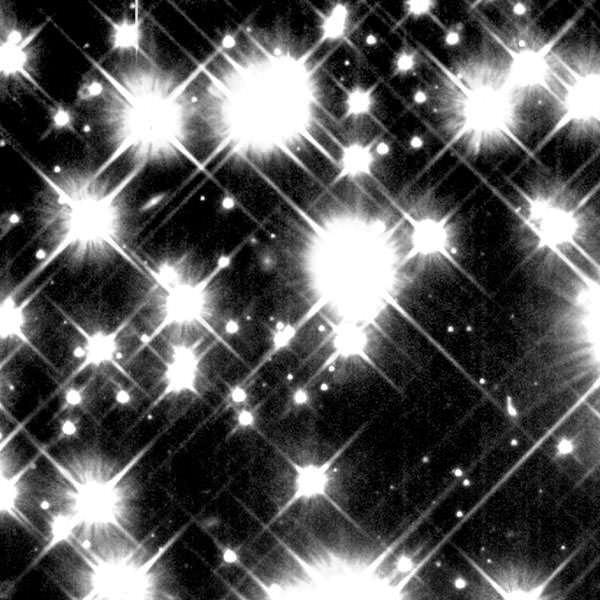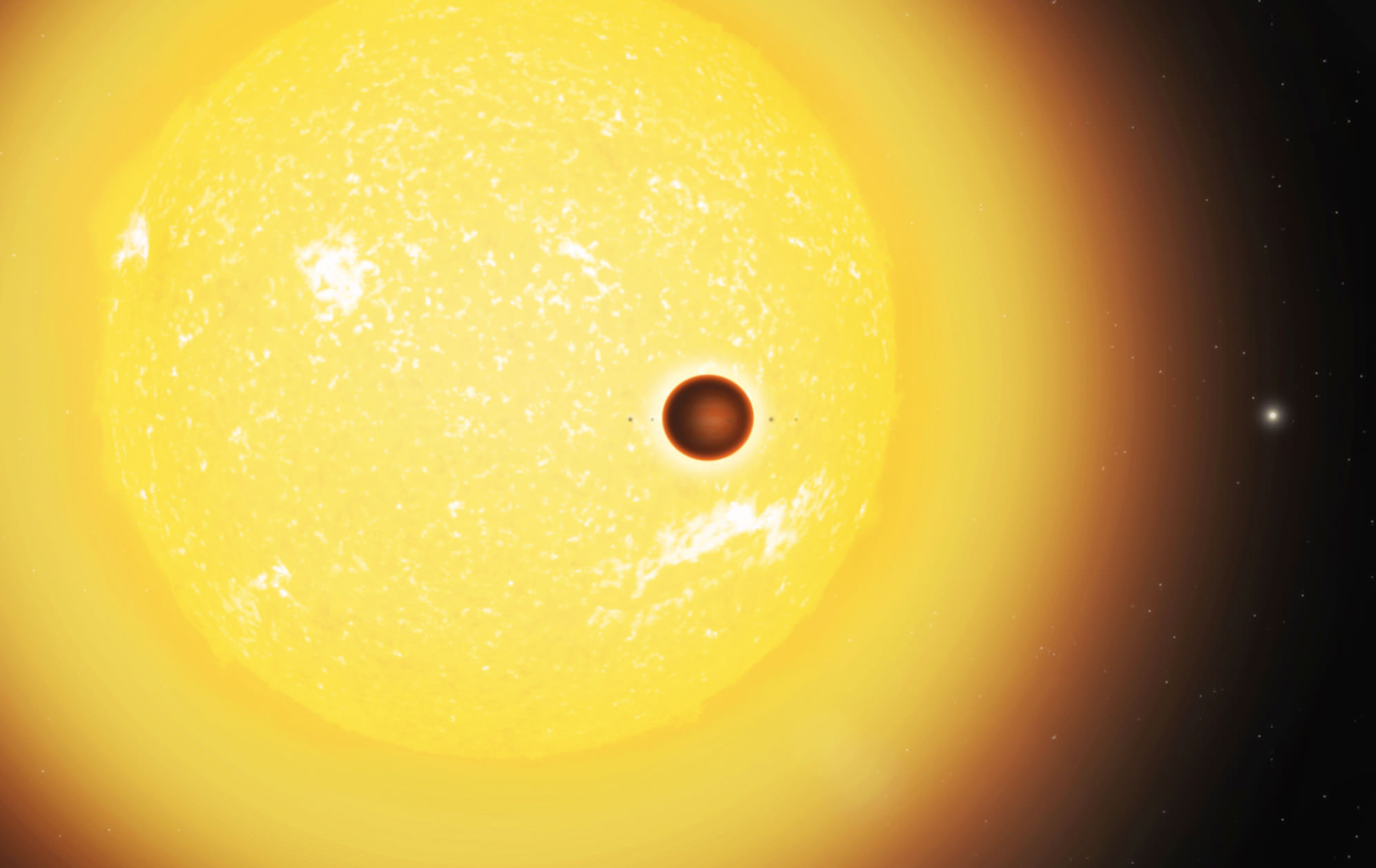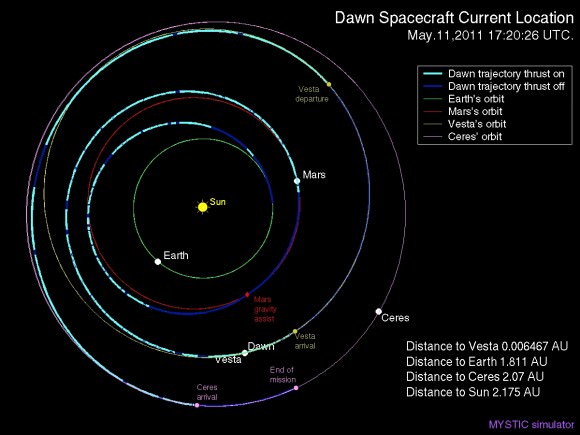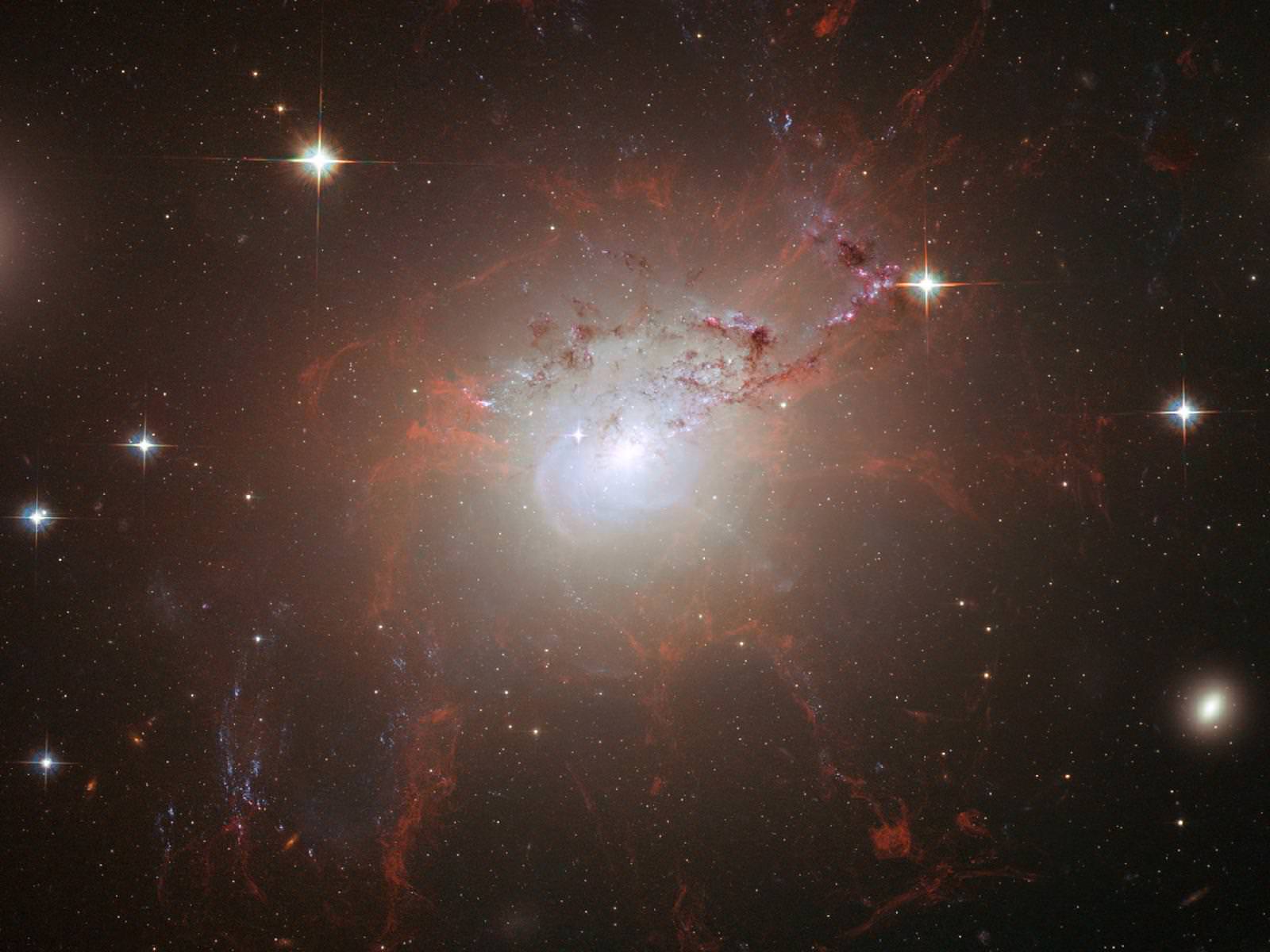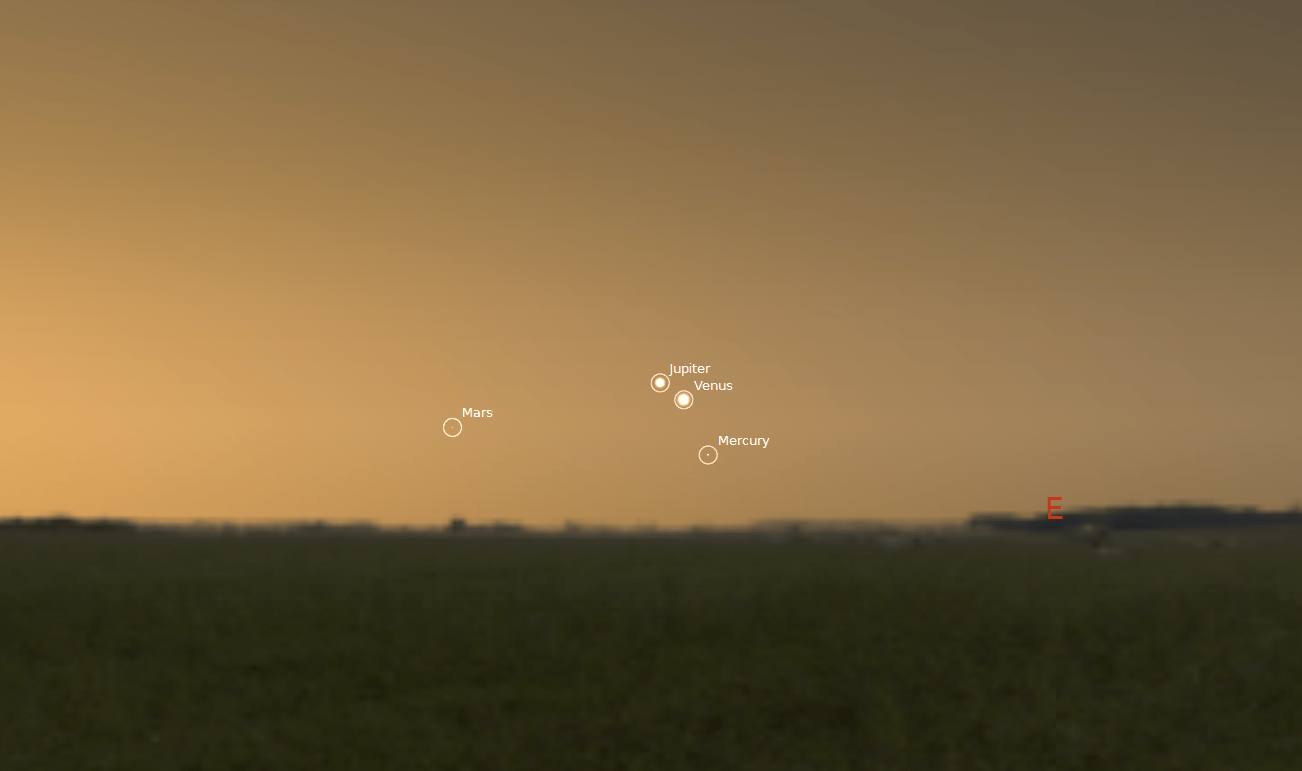The Solar Dynamics Observatory captured some plasma streaming off the Sun, doing a quick dance, and diving back into the surface. This video zooms into an active region over two days (Apr. 30 – May 2, 2011). The cloud of ionized gas, or plasma that comes off the Sun is caused by an active, erupting sunspot. Why does the plasma return instead of streaming off into space? Magnetic forces are pulling the material along magnetic field lines on the Sun, and the plasma follows the Sun’s magnetic fields as it flies outwards, and either returns to the Sun or goes out into space. Here, the plasma returned. What you are seeing is ionized Helium at about 60,000 degrees C. in extreme ultraviolet light.
Where In The Universe #148
Here’s this week’s image for the Where In The Universe Challenge, to test your visual knowledge of the cosmos. You know what to do: take a look at this image and see if you can determine where in the universe this image is from; give yourself extra points if you can name the spacecraft/telescope responsible for the image. We’ll provide the image today, but won’t reveal the answer until later. This gives you a chance to mull over the image and provide your answer/guess in the comment section. Please, no links or extensive explanations of what you think this is — give everyone the chance to guess.
UPDATE: The answer has now been posted below.
I admit, I too thought this was the Lights of Zetar at first glance, but then learned it is a Hubble close-up of ancient white dwarf stars in the Milky Way Galaxy. Hubble peered deep into the globular star cluster M4 and was able to detect the white dwarfs which are no more luminous than a 100-watt light bulb seen at the moon’s distance from Earth. Hubble reveals a total of 75 white dwarfs in one small area within M4 out of a total of about 40,000 white dwarfs that the cluster is predicted to contain.
See more info at the HubbleSite.
Hubble Hunts Down Star Formation in Canes Venatici
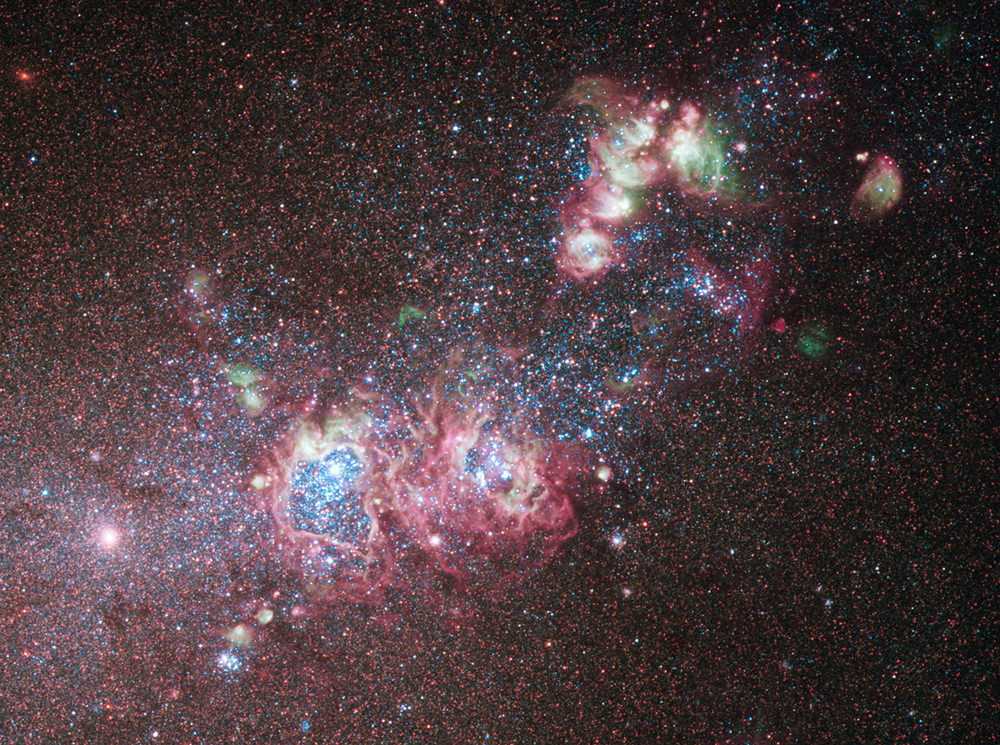
[/caption]
Lots of activity taking place inside NGC 4214, and Hubble has peered inside this dwarf galaxy to see stars in all stages of their evolution, as well as gas clouds with huge cavities blown out by stellar winds. Wow! Also visible are bright stellar clusters and complex patterns of glowing hydrogen, some forming a candy-cane-like structure in the upper right of this optical and near-infrared image. NGC 4214 is located in the constellation of Canes Venatici (The Hunting Dogs), about 10 million light-years away. Hubble scientists say this galaxy is an ideal laboratory to research the triggers of star formation and evolution.
Observations of this dwarf galaxy have also revealed clusters of much older red supergiant stars. Additional older stars can be seen dotted all across the galaxy. The variety of stars at different stages in their evolution indicates that the recent and ongoing starburst periods are not the first, and the galaxy’s abundant supply of hydrogen means that star formation will continue into the future.
This color image was taken using the Wide Field Camera 3 in December 2009. See the HubbleSite for a larger view of this colorful galaxy.
The Flip Side of Exoplanet Orbits
[/caption]
It was once thought that our planet was part of a “typical” solar system. Inner rocky worlds, outlying gas giants, some asteroids and comets sprinkled in for good measure. All rotating around a central star in more or less the same direction. Typical.
But after seeing what’s actually out there, it turns out ours may not be so typical after all…
Astronomers researching exoplanetary systems – many discovered with NASA’s Kepler Observatory – have found quite a few containing “hot Jupiters” that orbit their parent star very closely. (A hot Jupiter is the term used for a gas giant – like Jupiter – that resides in an orbit very close to its star, is usually tidally locked, and thus gets very, very hot.) These worlds are like nothing seen in our own solar system…and it’s now known that some actually have retrograde orbits – that is, orbiting their star in the opposite direction.
“That’s really weird, and it’s even weirder because the planet is so close to the star. How can one be spinning one way and the other orbiting exactly the other way? It’s crazy. It so obviously violates our most basic picture of planet and star formation.”
– Frederic A. Rasio, theoretical astrophysicist, Northwestern University
Now retrograde movement does exist in our solar system. Venus rotates in a retrograde direction, so the Sun rises in the west and sets in the east, and a few moons of the outer planets orbit “backwards” relative to the other moons. But none of the planets in our system have retrograde orbits; they all move around the Sun in the same direction that the Sun rotates. This is due to the principle of conservation of angular momentum, whereby the initial motion of the disk of gas that condensed to form our Sun and afterwards the planets is reflected in the current direction of orbital motions. Bottom line: the direction they moved when they were formed is (generally) the direction they move today, 4.6 billion years later. Newtonian physics is okay with this, and so are we. So why are we now finding planets that blatantly flaunt these rules?
The answer may be: peer pressure.
Or, more accurately, powerful tidal forces created by neighboring massive planets and the star itself.
By fine-tuning existing orbital mechanics calculations and creating computer simulations out of them, researchers have been able to show that large gas planets can be affected by a neighboring massive planet in such a way as to have their orbits drastically elongated, sending them spiraling closer in toward their star, making them very hot and, eventually, even flip them around. It’s just basic physics where energy is transferred between objects over time.
It just so happens that the objects in question are huge planets and the time scale is billions of years. Eventually something has to give. In this case it’s orbital direction.
“We had thought our solar system was typical in the universe, but from day one everything has looked weird in the extrasolar planetary systems. That makes us the oddball really. Learning about these other systems provides a context for how special our system is. We certainly seem to live in a special place.”
– Frederic A. Rasio
Yes, it certainly does seem that way.
The research was funded by the National Science Foundation. Details of the discovery are published in the May 12th issue of the journal Nature.
Read the press release here.
Main image credit: Jason Major. Created from SDO (AIA 304) image of the Sun from October 17, 2010 (NASA/SDO and the AIA science team) and an image of Jupiter taken by the Cassini-Huygens spacecraft on October 23, 2000 (NASA/JPL/SSI).
Crab Nebula Erupts in a Superflare

[/caption]
The famous Crab Nebula supernova remnant has erupted in an enormous flare five times more powerful than any flare previously seen from the object. On April 12, NASA’s Fermi Gamma-ray Space Telescope first detected the outburst, which lasted six days. Several other satellites also made observations, which has astonished astronomers by revealing unexpected changes in X-ray emission the Crab, once thought to be the steadiest high-energy source in the sky.
The nebula is the wreckage of an exploded star that emitted light which reached Earth in the year 1054. It is located 6,500 light-years away in the constellation Taurus. At the heart of an expanding gas cloud lies what is left of the original star’s core, a superdense neutron star that spins 30 times a second. With each rotation, the star swings intense beams of radiation toward Earth, creating the pulsed emission characteristic of spinning neutron stars (also known as pulsars).
Apart from these pulses, astrophysicists believed the Crab Nebula was a virtually constant source of high-energy radiation. But in January, scientists associated with several orbiting observatories, including NASA’s Fermi, Swift and Rossi X-ray Timing Explorer, reported long-term brightness changes at X-ray energies.
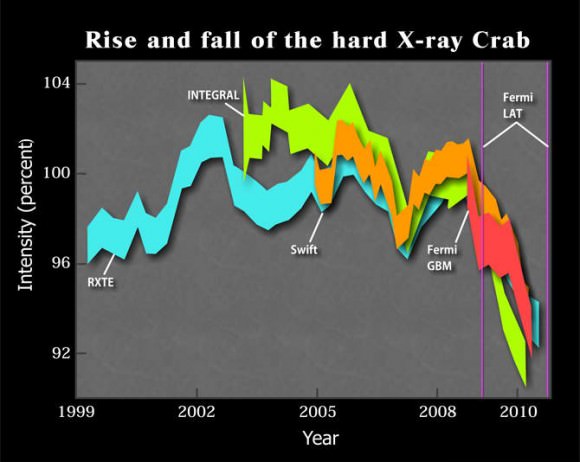
“The Crab Nebula hosts high-energy variability that we’re only now fully appreciating,” said Rolf Buehler, a member of the Fermi Large Area Telescope (LAT) team at the Kavli Institute for Particle Astrophysics and Cosmology, a facility jointly located at the Department of Energy’s SLAC National Accelerator Laboratory and Stanford University.
Since 2009, Fermi and the Italian Space Agency’s AGILE satellite have detected several short-lived gamma-ray flares at energies greater than 100 million electron volts (eV) — hundreds of times higher than the nebula’s observed X-ray variations. For comparison, visible light has energies between 2 and 3 eV.
On April 12, Fermi’s LAT, and later AGILE, detected a flare that grew about 30 times more energetic than the nebula’s normal gamma-ray output and about five times more powerful than previous outbursts. On April 16, an even brighter flare erupted, but within a couple of days, the unusual activity completely faded out.
“These superflares are the most intense outbursts we’ve seen to date, and they are all extremely puzzling events,” said Alice Harding at NASA’s Goddard Space Flight Center in Greenbelt, Md. “We think they are caused by sudden rearrangements of the magnetic field not far from the neutron star, but exactly where that’s happening remains a mystery.”
The Crab’s high-energy emissions are thought to be the result of physical processes that tap into the neutron star’s rapid spin. Theorists generally agree the flares must arise within about one-third of a light-year from the neutron star, but efforts to locate them more precisely have proven unsuccessful so far.
Since September 2010, NASA’s Chandra X-ray Observatory routinely has monitored the nebula in an effort to identify X-ray emission associated with the outbursts. When Fermi scientists alerted astronomers to the onset of a new flare, Martin Weisskopf and Allyn Tennant at NASA’s Marshall Space Flight Center in Huntsville, Ala., triggered a set of pre-planned observations using Chandra.
It was also observed by NASA’s Rossi X-Ray Timing Explorer (RXTE) and Swift satellites and the European Space Agency’s International Gamma-Ray Astrophysics Laboratory (INTEGRAL). The results confirm a real intensity decline of about 7 percent at energies between 15,000 to 50,000 eV over two years. They also show that the Crab has brightened and faded by as much as 3.5 percent a year since 1999.
“Thanks to the Fermi alert, we were fortunate that our planned observations actually occurred when the flares were brightest in gamma rays,” Weisskopf said. “Despite Chandra’s excellent resolution, we detected no obvious changes in the X-ray structures in the nebula and surrounding the pulsar that could be clearly associated with the flare.”
Scientists think the flares occur as the intense magnetic field near the pulsar undergoes sudden restructuring. Such changes can accelerate particles like electrons to velocities near the speed of light. As these high-speed electrons interact with the magnetic field, they emit gamma rays.
To account for the observed emission, scientists say the electrons must have energies 100 times greater than can be achieved in any particle accelerator on Earth. This makes them the highest-energy electrons known to be associated with any galactic source. Based on the rise and fall of gamma rays during the April outbursts, scientists estimate that the size of the emitting region must be comparable in size to the solar system.
NanoSail-D Caught on Video
When you have an automated video camera, it’s amazing what you can pick up in the night sky. Dr. Robert Suggs used the Automated Lunar and Meteor Observatory at Marshall Space Flight Center to catch NanoSail-D on video as it slipped across the sky back on March 2nd, 2011. This video is from the small finder camera for the observatory and the solar sail appears just how it would be seen by the naked eye. The NanoSail-D twitter feed said that this video is actually upside down. “I am actually sailing out of the trees and higher into the night sky,” the solar sail Tweeted. The same facility also captured images of NanoSail-d with 80mm and 14″ telescopes.
NanoSail-D won’t be visible for very much longer, just a couple of weeks or less until it will burn up in the atmosphere. See our previous article on how to observe NanoSail-D before it de-orbits.
Source: NanoSail-D website
Photopic Sky Survey
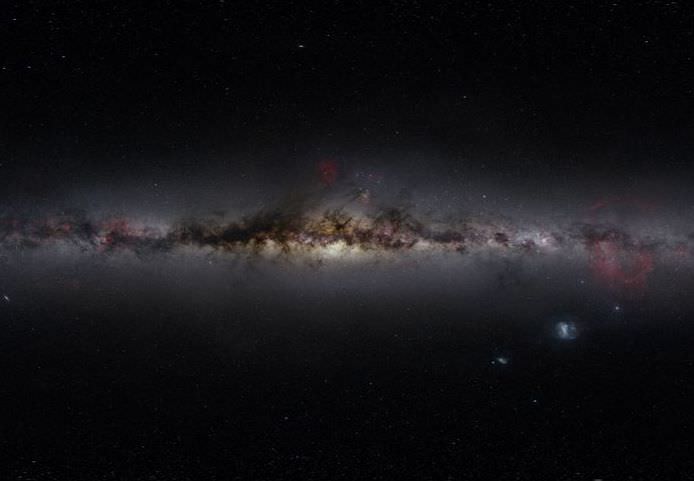
[/caption]
The Photopic Sky Survey, the largest true-color all-sky survey – along with a constellation and star name overlay option – is available here.
For more detail on how it was created read on…
Nick Risinger decided to take a little break from work and embark on a 45,000 miles by air and 15,000 by land journey – along with his Dad, brother and a carload of astrophotography gear – to capture the biggest true color picture of the universe ever. As you do…
The requirement for the long journey is all about trying to snap the whole universe from the surface of a rotating planetary body in a solar orbit – and with a tilted axis yet. So what might be seen in the northern hemisphere isn’t always visible from the south. Likewise with the seasons, what may be overhead in the summer is below the horizon in the winter.
On top of that, there are issues of light pollution and weather to contend with – so you can’t just stop anywhere and snap away at the sky. Nonetheless, with a navigational computer to ensure accuracy and over the course of one year – Risinger broke the sky down into 624 areas (each 12 degrees wide) and captured each portion through 60 exposures. Four short, medium, and long shots with each of six cameras were taken to help reduce noise, satellite trails, and other inaccuracies.
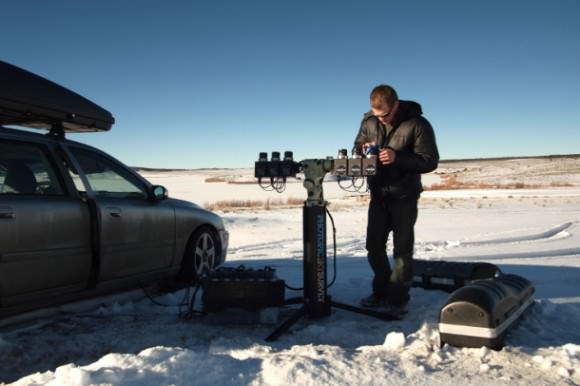
Further reading: Photopic Sky Survey home page (includes a description of the hardware and software used).
Dawn Begins Approach to Asteroid Vesta and Snaps First Images
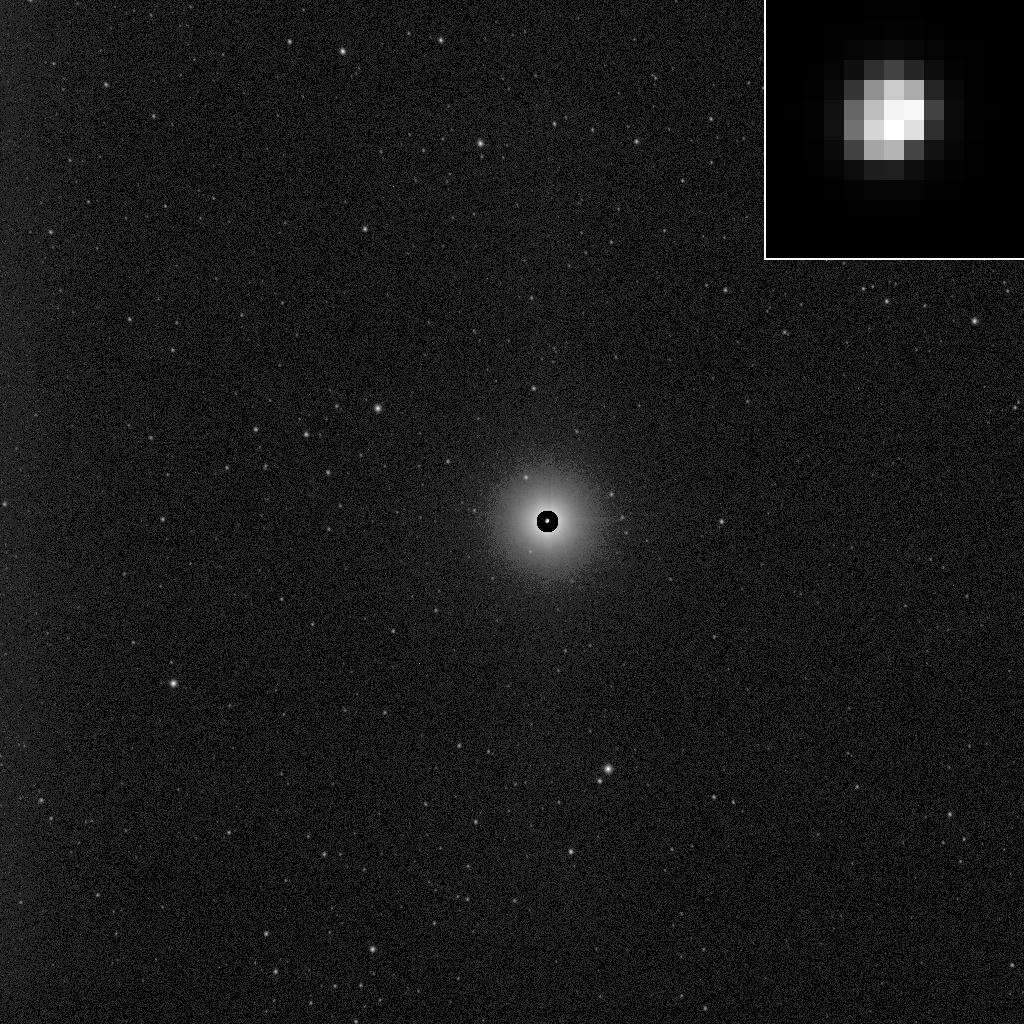
[/caption]
NASA’s revolutionary Dawn Asteroid Orbiter has begun the final approach phase to the giant asteroid Vesta and snapped its first science image. The image was taken on May 3, when Dawn was approximately 1.21 million kilometers (752,000 miles) distant from Vesta using the science imager known as the Framing Camera.
Besides the pure delight of seeing Vesta up close for the first time, the images play a crucial role in navigating Dawn precisely through space and successfully achieve orbit around the protoplanet that nearly formed into a full fledged planet.
Vesta is the second most massive object in the Asteroid Belt and is 530 kilometers (330 miles) in diameter.
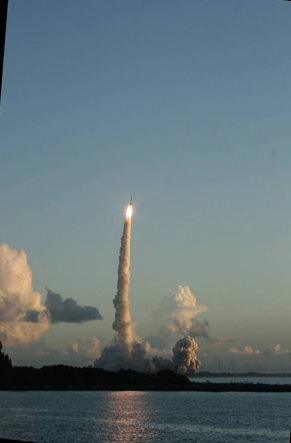
Dawn should be captured into orbit about Vesta around July 16 as the engineering team works to maneuver the spacecraft to match the asteroids path around the sun using the exotic ion thrusters. Using the background stars in the framing camera images, they will be able to determine Dawn’s location in space relative to the stars in order to precisely navigate the spacecrafts trajectory towards Vesta.
“After plying the seas of space for more than a billion miles, the Dawn team finally spotted its target,” said Carol Raymond, Dawn’s deputy principal investigator at NASA’s Jet Propulsion Laboratory in Pasadena, Calif. “This first image hints of detailed portraits to come from Dawn’s upcoming visit.”
The best images of Vesta to date were taken by the Hubble Space Telescope. Jim Adams, Deputy Director of Planetary Science, told me that the images from Dawn’s Framing Camera will exceed those from Hubble in a few weeks.
Dawn will initially enter a highly elliptical polar orbit around Vesta and start collecting science data in August from an altitude of approximately 1,700 miles (2,700 kilometers). The orbit will be lowered in stages to collect high resolution data as Dawn spends about a year collecting data from its three science instruments.
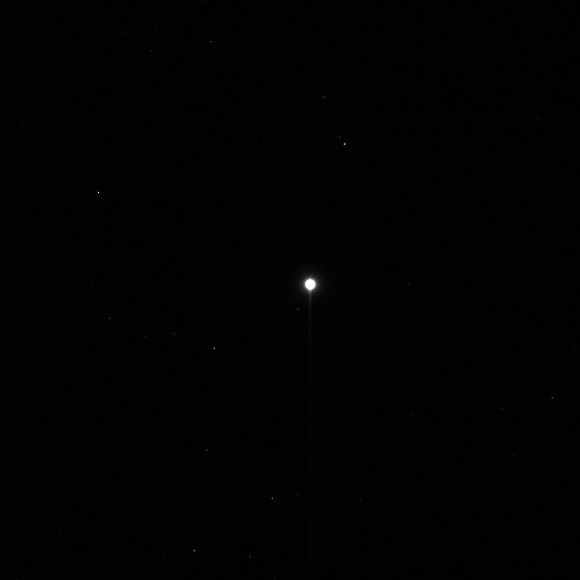
This image shows the first, unprocessed image obtained by NASA's Dawn spacecraft of the giant asteroid Vesta in front of a background of stars. It was obtained by Dawn's framing camera on May 3, 2011, from a distance of about 1.2 million kilometers (750,000 miles). Vesta is inside the white glow at the center of the image. The giant asteroid reflects so much sunlight that its size is dramatically exaggerated at this exposure. Image credit: NASA/JPL-Caltech/UCLA/MPS/DLR/IDA
Thereafter Dawn will be targeted to Ceres, the largest object in the Asteroid Belt which it will reach in 2015.
Dawn is an international mission.
The framing cameras have been developed and built under the leadership of the Max Planck Institute for Solar System Research, Katlenburg-Lindau, Germany, with significant contributions by the German Aerospace Center (DLR) Institute of Planetary Research, Berlin, and in coordination with the Institute of Computer and Communication Network Engineering, Braunschweig. The framing camera project is funded by the Max Planck Society, DLR, and NASA.
The Visible and Infrared mapping camera was provided by the Italian Space Agency. The Gamma Ray Detector was supplied by Los Alamos National Labotatory.
Read more about Dawn in my prior story:
Revolutionary Dawn Closing in on Asteroid Vesta with Opened Eyes
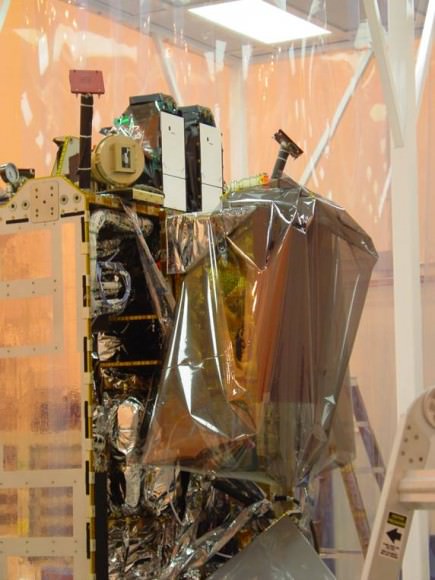
Energizing the Filaments of NGC 1275
[/caption]
When examining clusters of galaxies, astronomers often find massive elliptical galaxies lurking at the centers. In some of these, long filaments of gas and dust extend outwards from the core. One of the best examples of this is the relatively nearby galaxy NGC 1275 which lies in the constellation of Perseus. In this galaxy these tendrils are exceptionally narrow, only about 200 light years across, but as long as 20,000 light years in length. While many groups have studied them, their nature is a topic of much debate. The structures tend to be far removed from star forming regions which can cause the gas to glow. So what energy source powers these gaseous ribbons?
Answering this question is the goal of a recent paper by a team of astronomers led by Andrew Fabian at Cambridge University. Previous studies have explored the spectra of these filaments. Although the filaments have strong Hα emission, created by warm hydrogen gas, the spectra of these tendrils are unlike any nebulae within our own galaxy. The closest resemblance to galactic objects was the Crab Nebula, the remnant of a supernova that was witnessed in 1054 AD. Additionally, the spectra also reveal the presence of molecules such as carbon monoxide and H2.
Another, previous challenge astronomers faced with these tendrils was explaining their formation. Since molecules were present, it meant the gas was cooler than the surrounding gas. In this case, the clouds should collapse due to their self gravity to form more stars than are actually present. But surrounding these tendrils is ionized plasma which should interact with the cold gas, heating it and causing it to disperse. While these two forces would counteract one another, it is impossible to consider that they would balance each other perfectly in one case, let alone for the numerous tendrils in numerous central galaxies.
This problem was apparently solved in 2008, when Fabian published a paper in Nature suggesting that these filaments were being columnated by extremely weak magnetic fields (only 0.01% the strength of Earth’s). These field lines could prevent the warmer plasma from directly entering the cold filaments since, upon interaction with the magnetic field, they would be redirected. But could this property help to explain the lesser degree of heating that still causes the emission spectra? Fabian’s team thinks so.
In the new paper, they suggests that some of the particles of the surrounding plasma do eventually penetrate the cold tendrils which explains some of the heating. However, this flow of charged particles also affects the field lines themselves inducing turbulence which also heats the gas. These effects make up the main bulk of the observed spectra. But the tendrils also exhibit an anomalous amount of X-ray flux. The team proposes that some of this is due to charge exchange in which the ionized gas entering the filaments steals electrons from the cold gas. Unfortunately, the interactions are expected to be too infrequent to explain all of the observed X-rays leaving this portion of the spectrum not fully explained by the new model.
In this article I’ve used the words “magnetic field”, “charge”, and “plasma” throughout, so of course the Electric Universe crowd is going to come flocking, declaring this validates everything they’ve ever said, just as they did when magnetic fields were first implicated in 2008. So before closing completely, I want to take a bit to consider how this new study conforms to their predictions. In general, the study agrees with their claims. However, that doesn’t mean their claims are correct. Rather, it implies they’re worthlessly vague and can be made to fit any circumstance that even briefly mentions such words as I listed above.
The EU supporters consistently refuse to provide any quantitative models which could provide true discriminating tests for their propositions. Instead, they leave the claims suspiciously vague and insist that complex physics is completely understandable with no more understanding than high school level E&M. As a result, the mere scale of their claims is horrifically inconsistent wherein they propose things like the paltry field in this article, or the slight charge on lunar craters are indicative of overwhelming currents powering stars and entire galaxies.
So while articles like this one do reinforce the EU position that electromagnetics does play a role in astronomy, it does not support the grandiose claims on entirely different scales. In the meantime, astronomers don’t argue that electromagnetic effects don’t exist (like EU supporters frequently claim). Rather, we analyze them and appreciate them for what they are: Generally weak effects that are important here and there, but they’re not some all powerful energy field pervading the universe.
Dawn Planetary Delights
[/caption]
During the month of May, four bright Planets will grace the morning sky just before dawn.
The planets Venus, Jupiter, Mercury and Mars will be involved in a series of conjunctions (close together) and will finally be joined by the thin crescent moon at the end of the month.
Twice during May some of the planets will converge to form a trio, where 3 planets will fit in an imaginary circle roughly 5 degrees across.
On the 11th Mercury, Venus and Jupiter will be within 2.5 degrees of each other, forming a very tight trio and on the 21st another trio will be formed by Mercury, Venus and Mars.
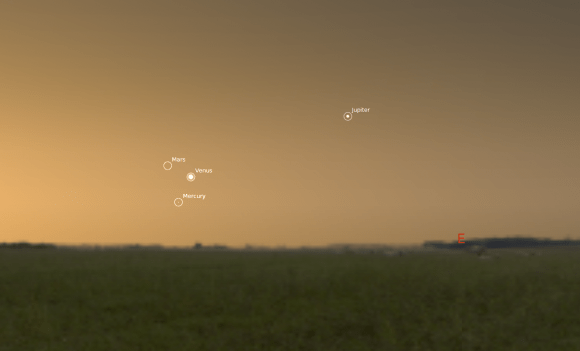
On the 29th, 30th, and 31st, the waning crescent moon will arrive, moving past Jupiter, Mars, Venus and Mercury stretched out in a line across the eastern sky.
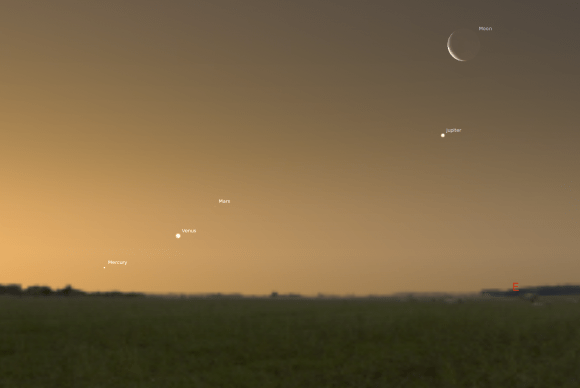
Unfortunately, these gatherings will be a challenge especially for observers in high latitudes, as the ecliptic in May is very shallow and low to the horizon. But if all you need is a challenge to get you out observing, then here’s your chance!
Venus and Jupiter should be easy objects to see, but Mercury and Mars will be very difficult, along with the crescent moon due to the onset of daylight.
Be careful as you will be viewing objects close to the sun. Never ever look at the sun with the naked eye, binoculars or a telescope as this will permanently damage your eyes or blind you. Viewing the sun can only be done with specialist solar telescopes and equipment.

